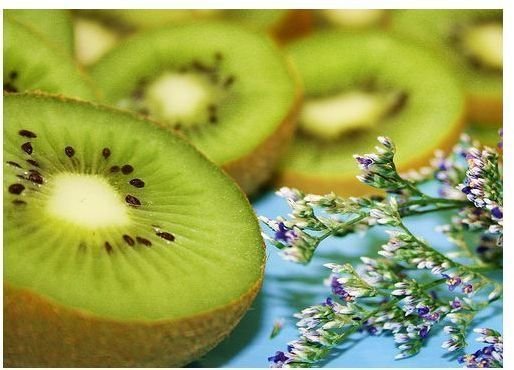What is the Nutritional Value of Kiwi?: Kiwi Fruit Nutrition
The Story of Kiwi
What is today known as kiwi, renowned for its unique flavor and nutritional value, was once an obscure fruit mostly unknown outside of China, called Yang Tao. The original variety, Actinidia chinensis, comes from the Yangtze Valley. Seeds were brought to both New Zealand and the United States at the beginning of the twentieth century. The crop flourished in New Zealand, where it was first called the Chinese gooseberry. It later became known as the kiwi fruit, named after the native New Zealand bird. Eventually, commercial crops developed in the United States as well, specifically California. Today, kiwi is cultivated in New Zealand and the United States, but also Italy, France, Chili, and Japan. In the 1990’s New Zealand kiwi was branded with a new name, Zespri kiwi.
Kiwi fruit has a soft, brown skin. The flesh is a bright, vibrant green, slightly creamy in texture, with a tangy, sweet flavor. It has become popular for its pleasing flavor profile, but kiwi fruit nutrition is also incredible. With very high antioxidant power, and a dynamic balance of nutrients, fiber, and even some essential fatty acids, the nutritional value of kiwi will certainly place this food among the ranks of the super fruits.
Vitamins
One kiwi supplies over one hundred percent of the daily recommended amount of vitamin C. This nutrient acts as a powerful antioxidant, and is likely responsible for the kiwi’s ability to protect cell DNA from free radical damage. It is also necessary for collagen production, immune health, and cell regeneration. Aside from the most powerful water-soluble antioxidant, vitamin C, kiwi is a good source of the fat-soluble antioxidant, vitamin E, which also acts to protect cells from damage, potentially preventing degenerative diseases and slowing the aging process.
Other important vitamins found in kiwi fruit include vitamin K, which is necessary for proper bone formation, and to prevent blood clotting; and, B-complex vitamins, which help to manage stress, metabolize food, and create energy. Kiwi is also a good source of folate, which acts to support a healthy heart, and helps prevent birth defects to a growing fetus.
Minerals
The nutritional value of kiwi includes a great balance of minerals.
- Calcium for healthy bones and teeth, as well as for cardiovascular well-being
- Iron for oxygenated blood and proper development
- Magnesium prevents the calcification of soft tissue, and is needed for enzyme activity
- Phosphorous for the healthy formation of bones and teeth, and cell growth
- Potassium to balance sodium in the body and manage blood pressure levels
- Copper for healing, bone and red blood cell formation, healthy nerves and joints
- Zinc is essential for a strong immune system; it also balances with copper
Other Benefits
With only 56 calories for one piece of fruit, the kiwi is a concentrated source of beneficial nutrients. Not only is it a great source of an array of vitamins and minerals, but kiwi fruit nutrition extends to its fiber and water content, omega fatty acids, and antioxidants. One serving supplies just over ten percent of the daily recommended amount of fiber, with three grams. Fiber is necessary for the body to eliminate waste efficiently, thereby preventing disease and health problems due to a build-up of toxins. Eating a kiwi fruit also helps the body cleanse itself naturally through hydration. It is a unique fruit source of omega-3 and omega-6 fatty acids, which are used for healthy hair and skin, brain health, and fortifying cell walls. Aside from vitamin C and vitamin E, kiwi is an excellent source of flavonoid and carotenoid antioxidants.
Integrating the Kiwi Fruit
For the nutritional benefits of kiwi, try making this food a regular part of your diet. Naturally-packaged in brown, fuzzy skin, this is a great fruit to carry on the go for a healthy snack. It can be peeled and sliced, or even cut in half and eaten with a spoon. Mix with strawberries, bananas, yogurt, and a little honey for an invigorating breakfast smoothie. Add to fruit salads, or even eat as a light dessert. Yang Tao, the Chinese gooseberry, kiwi, or even Zespri, this is a delicious, nutritious fruit that is meant to be enjoyed.
Resources
World’s Healthiest Foods https://www.whfoods.com/genpage.php?tname=foodspice&dbid=41#historyuse
Zespri Kiwifruit https://www.zesprikiwi.com/history.htm
Nutrition Data: Kiwi Fruit https://www.nutritiondata.com/facts/fruits-and-fruit-juices/1934/2
Balch, Phyllis, CNC. “Prescription for Nutritional Healing, 4th Edition.” (The Penguin Group, 2006).
Photo Credit
photo by: D Sharon Pruitt (CC/flickr) https://www.flickr.com/photos/pinksherbet/415651103/
